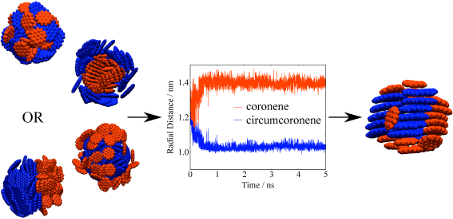Technical Report 210, c4e-Preprint Series, Cambridge
Partitioning of polycyclic aromatic hydrocarbons in heterogeneous clusters
Reference: Technical Report 210, c4e-Preprint Series, Cambridge, 2018
- The morphology of heterogeneous PAH clusters are investigated using replica exchange molecular dynamics.
- Stable heterogeneous PAH clusters consist of stacked PAHs in a core-shell structure, with larger PAHs in the core and smaller PAHs forming the shell.
- These low energy cluster structures are independent of initial configurations.
 The morphologies of heterogeneous clusters of polycyclic aromatic hydrocarbons (PAHs) are investigated using molecular modelling. Clusters of up to 100 molecules containing equal proportions of two different sized PAHs, circumcoronene and coronene or ovalene and pyrene, are evaluated. Replica exchange molecular dynamics simulations using an all-atom force field parameterised for PAHs sample many configurations at high and low temperatures to determine stable low energy structures. The resulting cluster structures are evaluated using molecular radial distances and coordination numbers, and are found to be independent of initial configuration and the cluster sizes studied. Stable clusters consist of stacked PAHs in a core-shell structure, where the larger PAHs are found closer to the cluster core and the smaller PAHs are located on the cluster surface. This work provides novel insight into the molecular partitioning of heterogeneous aromatic clusters, with particular relevance to the structure of nascent soot particles.
The morphologies of heterogeneous clusters of polycyclic aromatic hydrocarbons (PAHs) are investigated using molecular modelling. Clusters of up to 100 molecules containing equal proportions of two different sized PAHs, circumcoronene and coronene or ovalene and pyrene, are evaluated. Replica exchange molecular dynamics simulations using an all-atom force field parameterised for PAHs sample many configurations at high and low temperatures to determine stable low energy structures. The resulting cluster structures are evaluated using molecular radial distances and coordination numbers, and are found to be independent of initial configuration and the cluster sizes studied. Stable clusters consist of stacked PAHs in a core-shell structure, where the larger PAHs are found closer to the cluster core and the smaller PAHs are located on the cluster surface. This work provides novel insight into the molecular partitioning of heterogeneous aromatic clusters, with particular relevance to the structure of nascent soot particles.
Material from this preprint has been published in Carbon.
PDF (25.7 MB)



